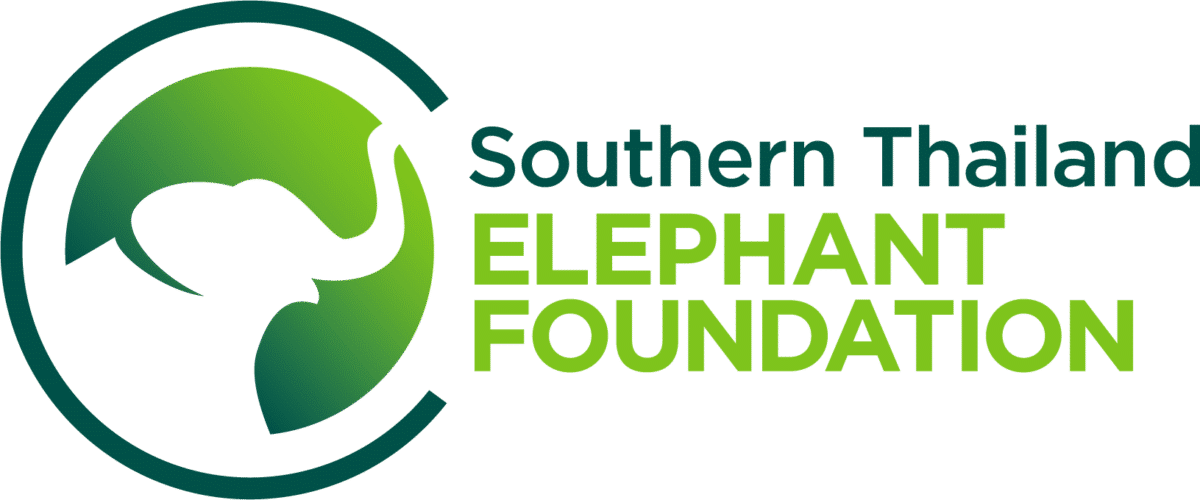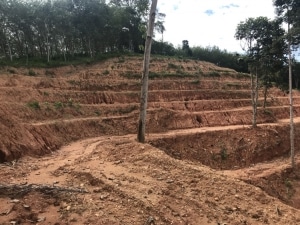Terraces for growing rice at Ban Ton Sae
Our last post was about the history and cultural importance of rice farming in Thailand. The huge increase in farming has caused serious problems for elephants in the last century, but we believe elephants could be the key to sustainable farming.
In order to feed the exponentially growing human population, over 90% of Thailand’s forested habitat has been converted into farmland. Elephant numbers have reflected this loss of habitat, plummeting from around 100,000 a century ago to perhaps 6-7,000 now (including both domesticated and wild elephants). Elephant migratory routes have also been disrupted by human settlements so wild elephants sometimes stray onto farmland in search of food, trampling and eating crops such that a farmer might lose all of his crops in a single overnight raid. Sadly, there are still hundreds of human and elephant fatalities every year in Asia, sometimes arising from farmers trying to defend their crops. Measures to deter or distract elephants such as electric fences, surveillance systems, natural barriers and alternative food sources can be successful, but are challenging and costly to implement. However, there are some impressive success stories in Thailand such as the famous Kui Buri National Park where wild elephants live in harmony with humans.
Human food can be unhealthy for elephants; starchy foods like bananas and grains are digested quickly, so if eaten in large quantities can lead to gut damage and constipation, which can kill elephants. A diet limited to mostly cultivated food also provides inadequate dietary variation for elephants. At STEF, we prioritise allowing elephants to browse the natural vegetation; wild elephants commonly eat over 100 plant species every year!
Where wild elephants roam the most frequently raided crops is rice, partly because of its abundance, but studies have shown that elephants often choose rice in preference to other common crops. The grassy stems provide many of the vitamins and minerals they need (see journal – Healthy Elephants). By strategically placing crops that elephants dislike, such as certain aromatic herbs, around rice plantations, it is possible to deter the elephants and reduce the temptation for them to move into rice fields.
Sustainable rice farming may, however, be one of the best ways to provide for both humans and elephants. After the grain has been harvested, elephants can eat the remainder of the plant, so nothing is wasted. At STEF’s Ban Ton Sae site, our rice crops will be shared between our elephants and the local people. We also have good relationships with local farmers, who will gladly accept our elephant manure as an eco-friendly alternative to chemical fertilisers, in exchange for pineapple leaves and other elephant food.
Natural elephant behaviours, often seen as a nuisance, can be used to mutual advantage. Elephants use their strong trunks to uproot huge clumps of grass for eating, which can help clear the land to be reused. In the wild, elephants even cultivate their own habitat. Their feeding activity disperses seeds and promotes new growth. By digging for salts, they build habitats where smaller species thrive. Their activity feeds development of whole ecosystems. If we can make use of these natural behaviours in captivity, we can farm sustainably alongside elephants, protecting them and preserving their respected place in Thai culture.
Find out more about sustainable farming research here:
http://ricepedia.org/thailand
http://agris.fao.org/agris-search/search.do?recordID=US201700242935
https://www.theguardian.com/global-development/2019/jan/30/miracle-method-sustainable-rice-scientists-dismissed


